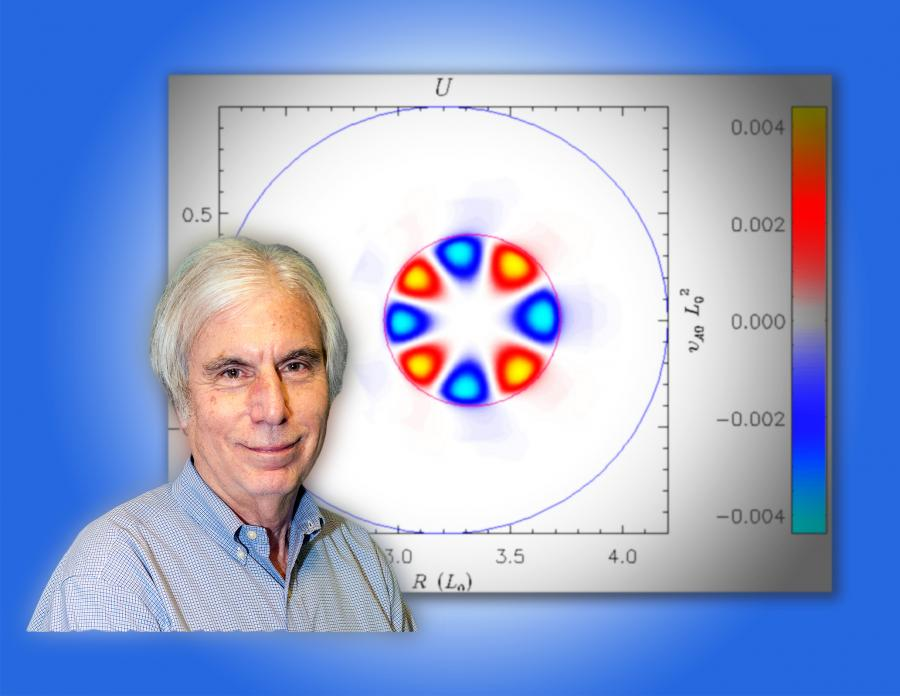Mar 31 2020
Researchers who are looking for ways to bring the fusion that drives the sun and stars to Earth should first tackle the instabilities of the sawtooth cycle—that is, up-and-down swings that occur in the central temperature and pressure of the plasma fueling fusion reactions, analogous to a saw’s serrated blades.
 Physicist Stephen Jardin with figure from paper. Image Credit: Elle Starkman/Office of Communications.
Physicist Stephen Jardin with figure from paper. Image Credit: Elle Starkman/Office of Communications.
If these up-and-down swings are sufficiently large, they can cause an abrupt collapse of the whole discharge of the plasma. Swings like these were originally seen in 1974 and since then have evaded a broadly accepted concept that elucidates the experimental observations.
Consistent with Observations
At the U.S. Department of Energy’s (DOE) Princeton Plasma Physics Laboratory (PPPL), scientists have now postulated a novel theory to describe the swings that take place in fusion facilities, or doughnut-shaped tokamaks.
According to the researchers, the theory, which was developed using high-fidelity computer simulations, seems to correspond with the observations made at the time of tokamak experiments.
Interpreting the process could be crucial for state-of-the-art fusion facilities, like ITER—the international experiment that is being built in France to prove the viability of fusion power.
Fusion typically integrates light elements in the form of plasma—that is, the hot and charged state of matter made up of atomic nuclei and free electrons—that produces large magnitudes of energy.
Researchers looking for ways to simulate fusion on Earth are planning to generate an almost inexhaustible supply of clean and safe power to produce electricity.
The latest discoveries reveal that when the pressure in the plasma core reaches a specific point, other instabilities can be activated that lead to sudden drops in temperature and pressure. Instabilities like these can result in stochastic—or jumbled—magnetic fields in the center of the plasma that leads to the sudden collapse, stated Stephen Jardin, a physicist and the study’s lead author, elucidating the process in the Physics of Plasmas journal. This has also been emphasized in “SciLight”—a featured publication of American Institute of Physics.
Most tokamak discharges exhibit sawteeth, and we’re trying to provide the theory of the physics behind them.
Stephen Jardin, Study Lead Author and Physicist, Princeton Plasma Physics Laboratory
The recent findings are completely different from a long-standing theory which states that the occurrence of the swings is an instability that results in magnetic reconnection—where the magnetic field lines in plasma break apart and snap together. “That theory has been around for over 40 years,” added Jardin.
Motivating New Theory
Earlier research works performed by PPPL have motivated the latest theory and shows how the instability that was believed to cause magnetic reconnection can actually self-stabilize the plasma. This is achieved by creating a localized voltage that inhibits the current in the plasma core from peaking sufficient enough to be exposed to magnetic reconnection.
The latest explanation holds that despite the suppression of magnetic reconnection, the increased heat in the plasma core can trigger localized instabilities that collectively act to flatten the temperature and pressure at the time of the sawtooth cycle.
This process was demonstrated by simulations created by codes devised by Jardin and Nate Ferraro, a physicist at PPPL and the study’s coauthor.
The novel instabilities can develop very quickly, and these are consistent with the sudden drop of heat observed in experiments that otherwise cannot be explained by the conventional theory.
A sophisticated model like this offers a new means to interpret the sawtooth phenomena. Going forward, the researchers wish to investigate the applicability of this model to various other tasks, like elucidating the evolution of “monster sawteeth” and applying high-powered radio frequency antennas to manage the sawtooth instabilities.
We want to develop a simulation model of a whole tokamak plasma, and this new theory of the sawteeth is an important part of the effort.
Stephen Jardin, Study Lead Author and Physicist, Princeton Plasma Physics Laboratory
The study’s coauthors include Isabel Krebs, a former post-doctoral physicist at PPPL currently at the Dutch Institute for Fundamental Energy Research (DIFFER), who improved the theory that the instability assumed to cause temperature collapse can potentially help to stabilize the plasma.
The latest study was financially supported by the DOE Office of Science and the SciDAC Center for Tokamak Transient Simulations.
Scientists produced the novel simulations at the National Energy Research Scientific Computing Center (NERSC)—a DOE Office of Science User Facility at Lawrence Berkeley National Laboratory.